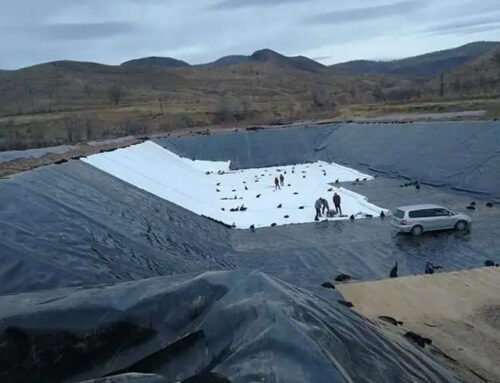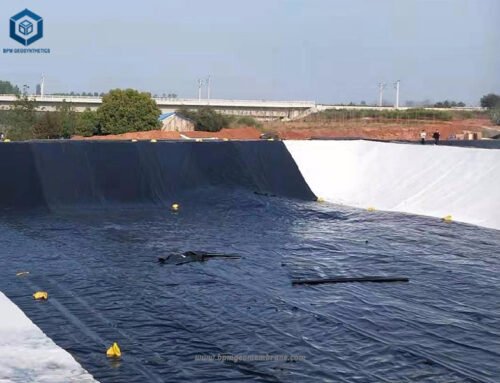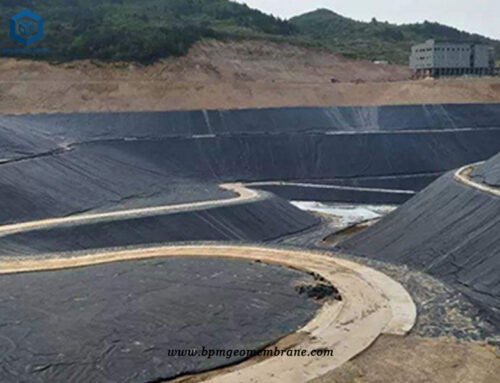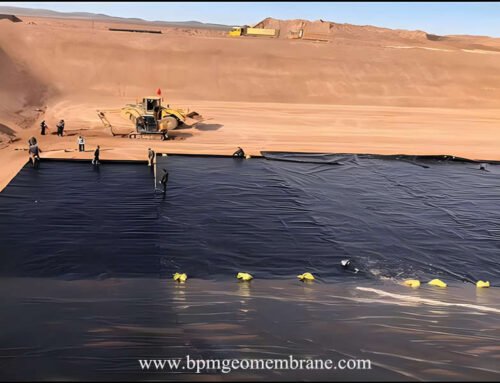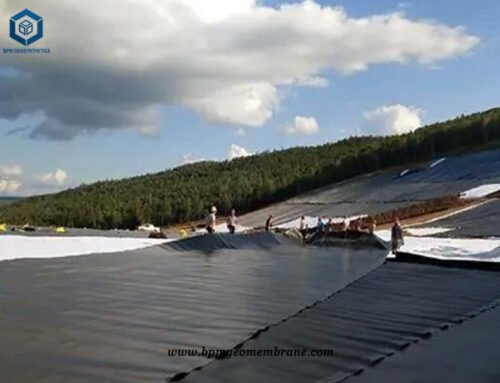The mining industry is generally considered to be the world’s largest producer of solid waste. Waste rock and tailings are the two main forms of mining waste. Membrane liners are used to retain the chemical solutions used to dissolve minerals in the ore and to allow leachate to collect. The 2mm plastic geotechnical membrane is a widely used HDPE geotechnical membrane made of high-density polyethylene using three-layer co-extrusion and blown film technology, adding carbon black, antioxidant, anti-aging, and anti-ultraviolet components. With excellent chemical and UV resistance, impermeability, high yield strength, and weld strength, HDPE lining is widely used as a lining system in civil engineering projects.
Case Study
- Destination: Myanmar
- Product: 2mm plastic geotechnical membrane
- Purpose: Heap Leaching Project
Issue
A customer from Myanmar found our company through Google. Through communication, we learned that the customer has a copper mine project located in central Myanmar, 110km away from Mandalay. The Chindun River flows through the east side of the mining area, with an area of 32.27 square kilometers. The project adopts a wet smelting process, heap leaching, and electrowinning to produce cathode copper. As a site for ore piles, heap leaching sites must have sufficient bearing capacity. At the same time, the base must have excellent anti-seepage capabilities to prevent infiltration and leachate from seeping into the ground, polluting soil and groundwater, and be able to collect solutions. In the copper hydrometallurgy heap leaching process, the anti-seepage system is key to the heap leaching process, because the anti-seepage system not only prevents the acidic heavy metal solution from penetrating into the ground to pollute the groundwater but also plays a role in collecting the leachate.
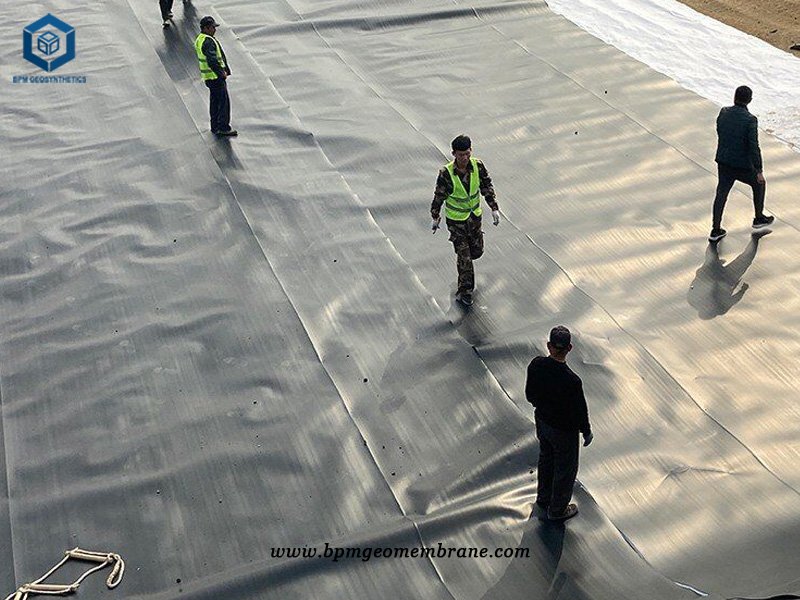

Solution
Knowing the customer’s project needs, we recommended the 2mm plastic geotechnical membrane for the customer’s copper ore heap leaching site project. Among all polyethylene materials, HDPE plastic geotechnical membrane has the highest density, which can reach 0.9400.965g/cm3, and its performance is different from ordinary polyethylene materials in many ways. HDPE plastic geotechnical membrane has excellent mechanical strength, heat resistance, and good elasticity. As the thickness increases, its breaking point strength, yield point strength, tear resistance, and puncture resistance gradually increase. The tensile strength of HDPE plastic geotechnical membrane can reach 2245MPa, the fracture secondary length can reach 200%900%, and the melting temperature is 126°C136°C. The permeability coefficient K of HDPE membrane is less than 10-13cm/s, and its impermeability is far superior to other anti-seepage materials. We provided the customer with samples of 2mm plastic geotechnical membrane under the GRI GM13 standard. After testing, the customer was very satisfied with all the indicators, and we quickly reached an order agreement.
Specification of HDPE Geotechnical Membrane Liner for Heap Leaching Project in Myanmar
- Geotechnical membrane thickness: 2mm
- Total Quantity: 500,000 square meters
- Each roll Size: 7m*100m
- Standard: ASTM GM13 standard
The advantagesof plastic geotechnical membrane are numerous and include
1. Chemical stability: HDPE plastic geotechnical membrane has excellent chemical stability and can resist corrosion from a wide range of chemicals, making it suitable for use in sewage treatment, chemical reaction tanks, and landfills.
2. Aging resistance: HDPE plastic geotechnical membrane has excellent anti-aging, anti-ultraviolet, and anti-decomposition capabilities, making it suitable for use in exposed applications, and with a service life of 50-70 years.
3. Anti-plant root system: HDPE plastic geotechnical membrane has excellent puncture resistance and can resist most plant roots, making it suitable for use in landscaping and other applications.
4. High mechanical strength: HDPE plastic geotechnical membrane has good mechanical strength, with a tensile strength at break of 28MPa and an elongation at break of 700%.
5. Cost-effective: HDPE plastic geotechnical membrane is cost-effective, with a production process that is more scientific and faster, and a production cost that is lower than traditional waterproof materials, saving about 50% of the cost.
6. Fast construction speed: HDPE plastic geotechnical membrane has high flexibility, with many specifications and various layout forms that can meet the anti-seepage requirements of different projects, making it easy and fast to install.
7. Environmentally friendly and non-toxic: HDPE plastic geotechnical membrane is non-toxic and environmentally friendly, with an anti-seepage principle that is an ordinary physical change that does not produce any harmful substances, making it a good choice for environmental protection, breeding, and drinking pools.
8. Good welding effect: HDPE plastic geotechnical membrane can be welded very well by a special welding machine, with a weld strength that is greater than the base metal strength, making it convenient for construction.
9. High tensile strength and good elasticity: HDPE anti-seepage membrane lining has high tensile strength and excellent elasticity, allowing it to overcome the uneven settlement of the base surface and making it suitable for expansion or contraction.


Installation of HDPE Plastic Geotechnical membrane
- The base surface of the geomembrane construction requires that the surface of the installation base should be tamped and leveled, and sharp objects such as tree roots, stones, glass and iron nails should be removed; the internal and external corners of the base should be trimmed and rounded, and the fillet radius ≥50cm, and the surface of the welding seam should be cleaned. Clean; the construction of geomembrane can be carried out after the acceptance and signature of the civil engineering and supervision construction party;
- The climate requirements for geomembrane construction should generally be above 5℃. The geomembrane should be tight at low temperatures, and the geomembrane should be relaxed at high temperatures. Geomembrane installation and construction should be appropriately pre-released to an extension of 2% to 5% according to the specific site conditions and the prevailing climatic conditions; the wind is below; when the temperature is too low, the construction should not generally be carried out in strong winds or rain and snow above level 4; in windy weather, When the wind affects the construction of the geomembrane, the geomembrane to be welded should be pressed firmly with big rocks or sand bags;
- The laying of geomembrane. The laying of geomembrane is the arrangement direction of the seam in the entire anti-seepage system parallel to the slope toe line, that is, it is arranged along the slope direction. When laying geomembrane, we should try to minimize the number of welds. Under the premise of ensuring quality, we should save raw materials as much as possible, and it is also easy to ensure quality. Usually in corners and deformed areas, the length of the joint should be as short as possible. In addition to requirements, on slopes with a slope greater than 1:6, within 1.5m from the top slope or stress concentration area, try not to install welds;
- During the laying of the geomembrane, artificial wrinkles should be avoided. When the temperature is low, it should be stretched and flattened as much as possible. After the geomembrane is set up, it is necessary to minimize walking and moving tools on the surface of the geomembrane. Anything that can cause harm to the geomembrane should not be placed on the geomembrane or carried on the film to avoid accidents to the geomembrane. damage;
- For the more critical process, the appearance quality of the geomembrane is unpacked and inspected before the film is laid, and the discovered mechanical damages, production wounds, holes, breakages and other defects are recorded and repaired. Before cutting the geomembrane, measure its relevant size, and then cut it according to the actual cutting. The lap width of the seam between the membrane and the membrane is 10cm~15cm, so that the direction of the seam arrangement is parallel to the slope foot line, that is, along Arrangement in slope direction;
In addition, in order to better guarantee the effect of the geomembrane construction, it is also necessary to pay attention to when laying the geomembrane, do not pull it too tightly, and leave a certain amount of expansion and contraction. At the same time, it should be noted that the protective layer must be well covered to avoid some heavy objects from damaging the geomembrane.
About BPM
BPM has been specializing in delivering complete line of geosynthetics products and solutions to worldwide customers since its foundation in 2007. BPM had provided many types of effective and state of the art geomembranes, geotextiles, geocells, geosynthetic clay liners (GCLs), drainage boards, geogrids to over 81 countries. Our main customers are from Australia, France, Sweden, UK, Hong Kong, Hungary, New Zealand, Poland, Mexico, Ecuador, Brazil, Pakistan, Bangladesh, Thailand, Vietnam, Malaysia, Indonesia, Singapore, Philippines, Sri Lanka, India, UAE, Saudi Arabia, Qatar, Kenya, Ghana, Ethiopia, Somalia, Nigeria, South Africa, Swaziland, Mongolia, etc.
BPM is not only manufacturing best quality geosynthetic products but also providing professional design and installation service. OEM, ODM, custom development and fabrication are also available. If you have any questions or inquiries, please fill and submit the following form, we will reply as soon as possible.

